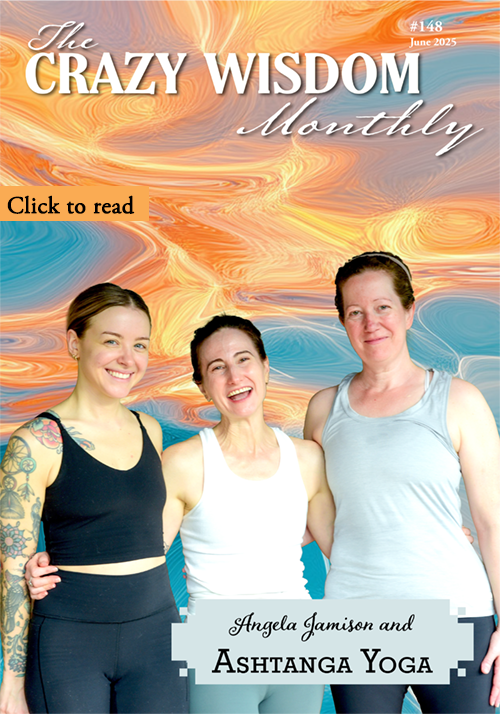By Trish Maley
At 6 a.m. I woke up to sit with my sangha. I showered and jumped on an early-morning Zoom meeting. Afterward, I had 30 minutes to whip up breakfast and eat before I had to pick up my other son.
I pulled out a pan and began frying eggs.
My 12-year-old son walked into the kitchen and opened the refrigerator.
“No milk?!” he snarled.
I had forgotten to pick it up the day before.
“There’s oat milk in there,” I said calmly.
“It’s gross! Great, this ruins my whole routine. Now I can’t eat breakfast!” He stormed off into his room and slammed the door.
I’m really good at anger; I always have been. The fight response in my threat system is ready to launch. If I wanted to slip back into my old baseline of anger in that moment, I had plenty of reasons to: I was in a rush, I was hungry, I was feeling unappreciated for the things I didn’t forget to do for my sons, I was feeling vulnerable at my son’s implication that my best wasn’t enough, and I was feeling blamed for “ruining” my son’s morning routine.
To cope, I could have become entangled in a storyline of how undervalued I am. I could have distracted myself by eating a few chocolate chips. I could have grabbed my phone and began scrolling. I could have started daydreaming about being on a mountain top away from all of this. But, this is how I learned how to meditate: not sitting for hours on a mountain top, transcending into light-filled states, but embodying these mundane moments in the midst of daily life.
Mindful meditation is about seizing opportunities to find the aliveness in the present moment—whether it is pleasant or unpleasant. The social media version of meditation is peacefully sitting on a quiet beach or monastery, eyes closed, posture in perfect form. But on a busy weekday morning, I was standing in my kitchen over a stove.
I felt it was best to take a mindful moment with cooking to regulate my nervous system since it was right in front of me. For example, I noticed what a deep golden yellow the yolk was, and I watched the sides of the egg white, cradled by foaming butter, bubble in the hot pan. I listened to the soft sizzle the egg made as it cooked. The kitchen smelled of chocolatey undertone as coffee brewed, and I drew my attention to how cold the bottoms of my feet felt on the kitchen tile. Next, I took a deep breath from my lower belly to fill up my lungs, taking in sips of air, and slowly exhaled. Bringing in the senses and deep breathing engaged the “rest and repair ” part of my parasympathetic nervous system, which is key to emotional regulation.
I felt a shift, and it took about a minute to do.
I slid my egg onto a plate and sat at my kitchen table. As I ate, I was able to access clarity to note prominent feelings I was experiencing. This is an important step for me because it helps me honor my feelings; otherwise, my reflex is to dismiss my feelings. However, if I dismiss them, it lessens my capacity to kindly hold space for other beings.
Honoring my feelings helps me create space and access compassion for family, friends, and even strangers. For example, I had the capacity to consider that maybe my son was just hungry, or he felt unsupported by me with his new morning routine.
It took less than ten minutes to navigate a mindful process to help regulate myself and get clarity. I paused, brought in the senses, accessed a deep breath, sat in my discomfort and vulnerability, and noted my prominent feelings. I practice on small stuff like this, and I practice with the big stuff. It’s a lot of undoing and I’m not going to get it right every single time.
If I want to skillfully manage my anger, it requires both parts of mindfulness: self-awareness and lovingkindness. Self-awareness is bringing things like conditioning, beliefs, and patterns to the surface. Lovingkindness is holding that awareness without judgment.
At this point I felt regulated enough to have a direct conversation with my son. I cleared the table and knocked on his door. I found him on the floor slouched against the wall on his phone, looking up at me.
“Can we talk?” I asked.
“Yeah,” he said, putting down his phone.
“Next time you are upset about there being no milk in the house, can you please take a pause? And say, ‘Hey mom, when you go out today can you pick up milk? I really wanted to have cereal this morning,’” I said gently.
“I can’t. It just comes flying out of my mouth,” he said coldly.
“I know. I’m asking that you practice pausing.”
“I know, mom…” he said slowly smiling.
I smiled back because at that moment I knew he had remembered our conversations on pausing and reactivity. I’m not asking him to perfect pausing—my request of him was to simply practice it… just as I do.
Twin sisters Trish Maley and Joy Aleccia have a business called Embracing Stillness. Embracing Stillness was born during the pandemic in order to adress pandemic stress. They teach mindfulness to children, teenagers, and adults through private sessions up to large workshops in the workplace. Maley and Aleccia have families
of their own and reside in the SoPac neighborhood. Follow them on Facebook
@EmbracingStillness or on Instagram @Embracingstilnesswithjoy. They can be reached by emailing embracingstillnesswithjoy@gmail.com.































































































































































































Raising a child with special needs comes with unique challenges, but it also brings moments of incredible growth, resilience, and joy. The proper support and strategies can make all the difference—whether it's navigating therapies, advocating at school, or creating a home environment where a child feels empowered. From practical tips to expert insights, community groups and carefully curated summer camps and classes, special needs children and their families will not just get by but will truly thrive. Every child deserves the chance to shine, and every family deserves the tools to help them do it.